Outcry of ‘indoctrination’ as school district dips toe into equity work
Education. Tension simmers over move to ‘culturally responsive’ teaching.
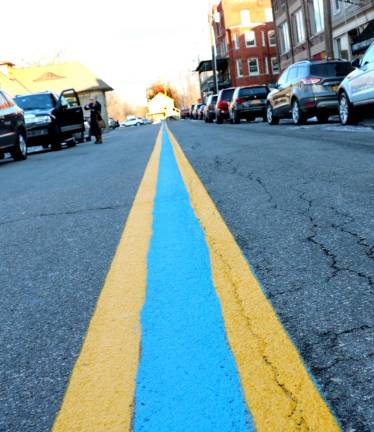
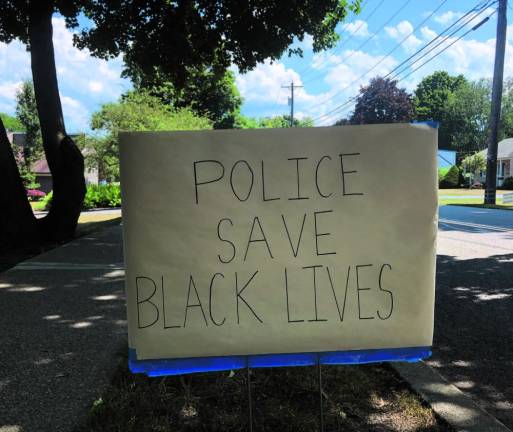
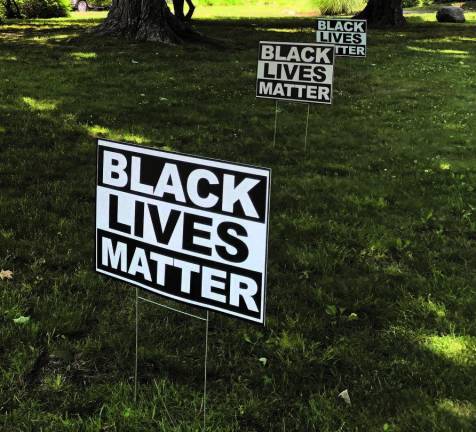
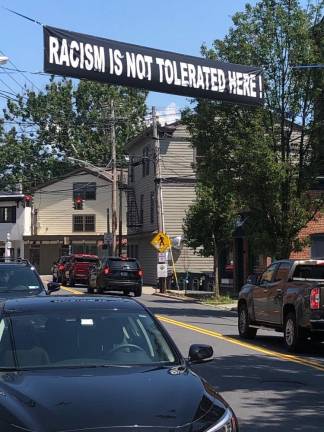
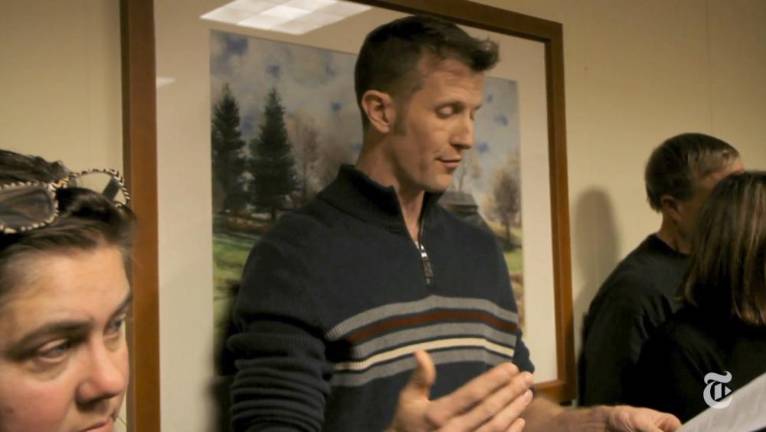
By Becca Tucker
June 16, 2022
Clarification
Last year, we ran this story about the community tension over Warwick Valley School District’s move toward a culturally responsive curriculum. Jason Wendell contacted us recently to say he was never a member of the Orange County Oath Keepers, and he did not have a run-in with the yoga teacher. In the absence of further evidence to the contrary we have updated the story by removing both references, in keeping with our commitment to fairness and accuracy.
__________________________________
Updated June 6, 2022, 12:45 p.m.
A group calling itself Warwick Parents for Common Sense took out an inflammatory ad in The Warwick Advertiser in March after the Warwick Valley School District announced it would adopt a “culturally responsive“ curriculum that supports inclusivity. The full page ad assailed the “Woke mob.”
On a tip, a phone call made to the supposed sponsor of the ad, Maurice Luftig, revealed the author’s real identity was Warwick resident Jason Wendell.
The ad has re-exposed the anger and division in the predominantly white town of Warwick.
The Culturally Responsive-Sustaining Education Framework the school was developed by New York State in 2018 as part of a nationwide zeitgeist that essentially seeks to turn diversity into an asset and teaching tool rather than seeing it as an obstacle.
As first steps, the Warwick Valley School District plans to survey families about school climate and form a committee, as early as June, including parents, administrators, board members and teachers and “representatives of all voices in the school community,” said Schools Superintendent Dr. David Leach.
The Warwick Parents for Common Sense ad attacked the “Black Lives Matter/Woke mob” for “labeling the citizens of this town as ‘racists’ and ‘White supremacists’” and attempting to “brainwash” students into “angry, radicalized allies of Leftism for the future, while shaming and silencing those who disagree.” It argues that the classroom should be free of political agendas and focus on “real-life skills in reading, writing and problem-solving.”
As for the true identity of the ad’s author, a call to the phone number Maurice Luftig provided as his number was answered by Jason Wendell. The father of three and New York City firefighter made a name for himself in 2016 when he stood up and read a statement denouncing “the Black Lives Matter lie” at a packed Warwick Town Hall meeting over the controversial blue line painted down Railroad Avenue. Wendell took aim at the “radicals (who) sit nice and comfortably in Warwick and make lazy, ill-informed condemnations of our police force... It’s time to confront you and shut you down. You have incited a war against our police.”
The Warwick Parents for Common Sense ad set up a similar dichotomy, pitting “Woke antagonists” against the fire department, the nuclear family and Western civilization. Wendell said he was busy when he picked up a call from this reporter in late March. By press time, numerous attempts to reach him had gone unanswered.
“I was a little surprised with the reaction,” said School Board President Sharon Davis of the backlash. Davis read aloud the 11 public comments – seven in favor of the equity work, four against, including one from Wendell – to cap off the March 4 school board meeting where the education equity work was discussed. That meeting had eight times more views than the previous school board meeting. “Because you know, if you’re student focused and you believe in meeting the needs of all students, you really shouldn’t be scared of something like the CR-S framework.”
Superintendent Leach describes the CR-S framework as one of many resources that the district’s hundreds of teachers will draw on to develop the rich curricula that Warwick is known for. Teachers are “empowered” to design and teach a curriculum, he explained, in which all students see themselves reflected. The mission is not only fulfilling state standards but also meeting children’s needs in a rapidly changing society.
The CR-S framework is written broadly, so that it can be employed to address not only issues like race-based achievement gaps, but also things like why girls still do not get through high school physics and computer science at the same rate as boys. The 64-page document calls out a “system of inequity — which routinely confers advantage and disadvantage based on linguistic background, gender, skin color, and other characteristics.”
All nine school board members are in support of the equity work, said Davis. “You have to have be living under a rock somewhere to not have experienced something that’s making you self-reflect and be more introspective,” she said. “Who is not looking at themselves differently, with everything we’ve experienced this year?”
The rift, in black and white
After the Warwick Parents for Common Sense ad ran, heated letters started coming into the paper on both sides. Most of the 18 letters intended for publication condemned the ad as a “misleading, racist rant,” a “rehash of right wing talking points” and a “provocative attempt to divide our town.” Several readers took the newspaper to task “for allowing this garbage to be published.”
Six of the letters to the editor expressed full-throated support for the ad. “There are many of us who agree,” said Marjory Fisher of Warwick. “I know of no family that wants their children to be taught such a far left ideology.”
“We will teach compassion and connection at home, let the school teach reading, writing, math etc.,” said James McGoewn of Warwick. “Thank you to the common sense parents for saying what the majority of our community sees as the attempt to infiltrate our schools with social engineering and indoctrination.”
A newcomer to Warwick, Kristin Dwyer was perplexed at the “vicious anger” expressed in the ad. “These neighbors are just furious that Black Lives Matter activists are disturbing the peaceful, idyllic image of Warwick they hold in their hearts by pointing out that racism exists, still now, even here, and suggesting we should do something about it,” she said.
“I think it runs deep,” said Greg Galluccio, of the rift that is once again being laid bare in Warwick. A Democratic candidate who is running for the all-Republican Warwick Town Board, Galluccio made a video condemning the Warwick Parents for Common Sense ad as a “horrific display of cowardice and unconcealed bigotry.”
Later the day we spoke, Galluccio attended a Warwick Town Board meeting whose agenda was another lightning rod with race at its core: a vote on the town’s plan for state-mandated police reform in the wake of George Floyd’s death. In February, Galluccio had been among a group of 50 signers of an open letter critiquing the local police reform efforts. That letter also made its public appearance as a full-page ad in this newspaper.
“I’m leaving a little shaken,” Galluccio said after the March 25 meeting where the town’s police reform plan – which he calls a “litany of platitudes” – was ratified. “I think I may have been the only Democrat in the room, and the crowd was loud and fired up about anyone who might have anything to say about Warwick law enforcement other than they are 100 percent perfect at what they do. It was disconcerting to hear some of the language being used to disparage anyone who may think differently. So you asked if there is a schism in this town, hell yes there is.”
Warwick is not unique, except perhaps in its appetite for good old letter writing. This tension has begun playing out around the country as education standards shift with the times. In Illinois, where state lawmakers voted to require culturally responsive teaching guidelines to be universal by 2025, similar objections surfaced: the new standards embed politics into teacher training, impose an ideological litmus test on educators, and prioritize social activism at a time when students are underperforming on tests.
Within the county, Warwick is looking to Valley Central School District in Montgomery, N.Y. as a forerunner. Valley Central formed a Racial & Social Equity Committee last summer, in the wake of the death of George Floyd. It was the first of a handful of districts across the region to hire facilitator Dr. Gess LeBlanc, a psychologist and Hunter College professor whom Warwick has also tapped to work with the district through June.
“Unfortunately, the work to a certain degree can become politicized,” acknowledged LeBlanc, at the virtual March 4 Warwick school board meeting. “In the times that we’re in, certain buzzwords tend to resonate. And so people hear equity, they hear cultural responsiveness, then all of a suddenly they think, ‘Okay, we’re moving in a certain direction,’” he said. “I’ve heard words like ‘indoctrinating children.’ I’ve heard words like ‘Okay, we’re going to have a curriculum that devalues certain members of our community. We’re moving in a direction that is going to silence certain members of our community.”
Communication breakdown
Full-page ads and outraged emails aside, actual dialog has been nonexistent.
Lavinia McNamara, the surrogate for “Luftig” who paid for the Warwick Parents for Common Sense ad, was uncomfortable talking to me, she said, because I had previously written a story about a firehouse sign that was taken down last summer after residents complained that it was racist. Warwick Parents for Common Sense does not have a public-facing presence, and its one public statement was penned under a fake name.
Of the nine detractors of the CR-S framework we reached out to, all declined to be interviewed for this story. One Warwick grandmother wrote a multi-page editorial and had a half-hour phone conversation with this reporter, resulting in a few paragraphs about her middle-of-the-road stance that we should focus on what makes us all human rather than what divides us – only to beg us not to use a single word of what she’d said because it was too stressful. Another picked up the phone to say she was “disgusted by journalism,” and if she were to talk, “the crazy liberals will hunt you down” and then she’d go to jail for shooting them.
McNamara, the mother of a third grader at Park Avenue Elementary School, did let loose in writing to the school board. “If the board is going to be wrongfully influenced, I won’t hesitate to pull my child out of the district and place him in private school,” she said. “Furthermore I will do everything in my power to sue the district to pull my tax dollars out of the district for their attempt to irreparably damage the psyche of my child and ruin his educational experience. Be aware I am not alone in feeling this way. The vast majority of Warwick hard-working parents will not sit idly by while this radical curriculum is pushed on our children.”
Roger Moss, an activist and retired teacher and entrepreneur, knows the depth of the chasm between worldviews better than most. After the 2016 election, Moss started meeting with Chip Murray, former Orange County Oath Keepers chapter leader, in an effort to find common ground. (Murray did not respond to an email by press time.) The group expanded to eight people: four liberals, including Moss, and four conservatives, including Murray and Jason Wendell. For six months, the group met up at a deli once or twice monthly to discuss things like the environment, food security or immigration. Whatever topic they embarked upon, they quickly found themselves at a dead-end, said Moss, with four people trying to convince the other four they were misguided.
“There’s always an element of some kind of truth or some kind of wisdom in either side of an argument,” said Moss. “I went into this believing that if I could express sympathy for their point of view, they’d do the same for mine and in the end that was not the dynamic.”
“I like Jason,” Moss went on. “I think he’s really searching as I wish every person would search for what their personal truth is. I think he believes this is an existential fight and he has no doubt he thinks he’s on the right side.” That was Moss’ takeaway: that each side feels threatened to the core by the other. Conservatives “feel that all will be lost if the progressives have their way. And so do the progressives feel that, if the conservatives have their way.”
Worldviews collide
We are increasingly living in separate bubbles, each fed by its own news sources and self-affirming social media algorithms. In one worldview, racism is essentially a thing of the past, or of elsewhere, and focusing on our differences constitutes an incomprehensible step backwards. “We are living in the most prosperous, least racist, least sexist nation on the face of the earth,” the Warwick Parents for Common Sense ad states. “What a blessing it is to live here in Warwick!”
“The factual foundation of our system is that all men are created equal, that they are endowed by their creator with inalienable rights,” said Warwick parent Jeff Kellan, in a written comment to the school board. “Certainly throughout our cherished history there are individuals who have violated these rights, but that does not dictate that all our systems and institutions are underpinned today by the mistakes of one’s ancestors.” The district, he wrote, should stick to the “facts, teach the history that is the foundation of our great American culture... the most diverse, most benevolent in the history of the world.” Kellan, who heads the North American supply chain for international shipping company Maersk, declined to be interviewed, citing the same firehouse sign story as McNamara.
In the other worldview, the beating of an old Asian woman on the street or the murder trial of Derek Chauvin serve as abject warnings of what can happen if we fail to help our children embrace difference in a diversifying country. “I’m terrified of this. I watch that trial, and I think about Derek Chauvin’s mother,” said Jamie Munkatchy, of Chester. Could Chauvin, or the cops who stood watching him kneel on George Floyd’s neck for nine minutes, be any of our sons, if they were to lose their way?
“I think a lot of what has to happen in our district in the next several years, and a project I’m super interested in, is just the education of white parents, probably white female parents,” said Munkatchy, the mother of an eighth grader at Warwick Valley Middle School. “Because I was raised this way, I was raised that color-blindness was the epitome of anti-racism, that I was lucky enough to be born in a colorblind and post-racial society. A lot of people in the middle, we just have to talk more and develop a language around why diversity and multiculturalism and pluralism is better for our white children. In the coming decades, if white men don’t have a framework for understanding why it’s better, they will just be fearful and fight. They will experience their loss of power as being robbed of their way of life, and not being able to see that the way of the way of life on the other side of this is better than what you have.”
A high school chemistry teacher at the James Baldwin School in the city, Munkatchy has been pushing her son’s district to do the hard work required for real equity rather than go through the motions and come out the other end with superficial tweaks.
“I need the district to be my partner in valuing equity diversity, to celebrate a world in which Black people and all people have power,” she said in a written comment to the school board. “Equitable distribution of power and resources is a beautiful thing and not something to be feared or resisted.”
This kind of work can take a decade, she said. Bringing about a shift in mindset – not only of teachers but all school staff, and parents, too – requires self-reflection, which can be uncomfortable. “A lot of self-reflection and unpacking in our district will be about being white and middle class,” she said. “Half of it is this recognition of power and privilege. That, I think there’ll be the biggest resistance to, because self-reflection is hard. I haven’t really met a lot of white people who like to talk about their power and privilege.”
Last summer, three race-based incidents rose to the level that Superintendent Leach wrote district-wide emails home to parents. One involved “a disturbing social media post containing racial epithets and threatening targeted violence against a home,” according to Leach’s email. Two involved students posting photos on social media with racial slurs written across their foreheads.
“Justifiably, it is causing profound outrage,” wrote Leach in June, referring to one such photo of a high school student. “We will not waver in fighting against unlawful, racist behavior. It has no place in our schools or community... The District continues to receive valuable feedback from many community stakeholders. This feedback will help us incorporate systemic interventions and training as strategies for reducing racial inequities, divisive harassment, and discrimination.”
The face-off
Home school. Move to Florida. Take over the school board. These are among the ideas being floated by people unhappy with the direction Warwick is headed.
Screen shots from the private Facebook group Warwick Parents for Common Sense began circulating in February, one showing Jason Wendell proposing the idea of running a slate of candidates – with a preference for local law enforcement or fire department officers – for the three open school board seats in the May 18 election.
In the widely circulated screen shot, Wendell says, “We are parents who have banded together to fight against Leftist indoctrination in the Warwick public schools. This includes BLM and the latest Race and gender theories.” In another, which had 82 likes, Wendell says, “We have a really great chance of launching a grass-roots effort to win the BOE, and bring our schools back to sanity.”
Susan Miller, a yoga teacher who served two terms on the Warwick School Board decades ago, re-posted one of the screen shots along with a message on the Warwick BIPOC Alliance Facebook page, urging people to assemble an “alternate slate” for the school board, potentially promoting anti-racist teaching. Miller, who knows Wendell personally, believes the school board fight is one strategy of a larger power play. “Town board, village board,” she said. “Because they want to influence not just education, but in general the town’s response to things like Black Lives Matter.”
School Board President Davis, whose seat is one of the three up for grabs, said that many people have picked up petitions to run for the school board, but not until the April 19 deadline for filing petitions will the public know who’s running.
As for how much influence three board members of nine would have over what actually goes on in classrooms, the jury is out. Board members we spoke to agreed that as individuals, you realize early on that you don’t have a lot of power. But in other districts, “rogue” board members – who infiltrate a board to advance an agenda at odds with the larger board’s – have been known to jam up the works, Miller said. Miller recalled two rogue members who got onto Warwick’s board with the intention of lowering taxes by cutting spending on things like “overpaid” teachers’ salaries. “When they saw how little they could do about that, one guy just stopped coming, so we ended up with one less board member,” Miller recalled. “But it was extremely disruptive. This would be much worse,” she said.
“I think there are people who probably silently sympathize with them,” said Miller. “If we don’t pay attention, we could end up with very different values being promoted.”